|
|
|
|
 |
 |
| |
 |
|
|
Original Articles |
|
|
|
|
|
Keywords :
acute pancreatitis, D-dimer, coagulation parameters |
|
|
Sukhbir Singh Badhal,1 Subhadra Sharma,1 Anoop Saraya,2 Asok Kumar Mukhopadhyay1
Department of Laboratory
Medicine,1
Department of Gastroenterology and
Human Nutrition Unit,2
All India Institute of Medical
Sciences,
New Delhi - 110029, India
Corresponding Author:
Dr. Anoop Saraya
Email: ansaraya@yahoo.com
DOI:
http://dx.doi.org/10.7869/tg.2012.48
Abstract
Aim: This study was conducted to assess the predictive value of coagulation abnormalities in determining disease severity and prognosis of acute pancreatitis (AP).
Methods: Patients of AP and 25 healthy volunteers were included in this prospective observational study. The final outcomes were disease severity assessed by Computed Tomography Severity Index, Acute Physiological Assessment and Chronic Health Evaluation – II, presence of organ failure and mortality. Prothrombin time (PT), partial thromboplastin time (PTT), thrombin time (TT), fibrinogen, antithrombin-III (AT-III), protein-C, and protein-S levels were assessed on day 0, 3 and 7 of admission.
Results: Of the 38 patients included, 13 died. Mean PT and TT were similar between patients and controls on any given day. PTT showed elevation on day 3 and 7 (p=0.001) compared to controls, although fibrinogen and D-dimer were significantly higher in patients on all days. Protein C and AT-III were significantly lower in patients and more so in non survivors ( (p=0.001)) than controls. Multiple logistic regression analysis revealed D-dimer levels >400 - 800 ng/ml and AT- III level of <71% at admission were associated with high mortality (OR 11.2, AUROC 0.70 and OR 16.6, AUROC 0.82 respectively) as well as predicted organ failure.
Conclusion: Serum D-dimer and antithrombin-III levels can be used to assess disease severity and predict outcome of patients with acute pancreatitis.
|
48uep6bbphidvals|533 48uep6bbph|2000F98CTab_Articles|Fulltext Acute pancreatitis (AP) presents with life threatening disease leading to increased mortality and morbidity in one-fifth of patients. One of the main pathophysiological aspects of AP is derangements in coagulation profile. Coagulation abnormalities are quite variable ranging from scattered intravascular thrombosis to severe disseminated intravascular coagulation (DIC).[1-7] Lasson and Ohlsson suggested that severe pancreatitis results in consumptive coagulopathy and fibrinolysis together with a local antiprotease deficiency.[1,2] In patients with AP, tissue factor (thromboplastin) released from the damaged organ, creates situations that favor thrombin formation.[8] Thrombin might play a critical role in inducing coagulopathy as well as in initiating many other aspects of inflammation.[8,9] Intrinsic, extrinsic or both pathway of coagulation are deranged in acute pancreatitis. However it is not clear which one precedes the other. All these changes are closely related to disease severity. Increased D-dimer levels are related to severity of pancreatitis and are associated with the activation of coagulation cascades leading to pre-DIC and DIC as the disease progresses.[10] The main aim of this study was to identify the early derangements in coagulation profiles of acute pancreatitis patients, assess their prognostic value,study the status of natural anticoagulants and to determine their relationship with other well established markers of AP severity.
Methods
This prospective observational study enrolled consecutive patients of AP who were admitted to the Gastroenterology Unit at All India Institute of Medical Sciences, New Delhi. Patients presenting with acute abdominal pain of suspected pancreatic origin, associated with at least three fold elevation in serum amylase or lipase were included in the study. The diagnosis of acute pancreatitis was confirmed by ultrasonography (USG) and/or contrast enhanced computed tomography (CECT). Patients with other primary disorders, history of hemorrhagic/thrombotic events were excluded from the study. Coagulation parameters (extrinsic pathway measured by prothrombin time; intrinsic pathway measured by activated partial thromboplastin time; common pathway measured by fibrinogen and thrombin time; fibrinolyis measured by Ddimers; and naturally occurring anticoagulants like antithrombin III and protein C and S) were measured at days 0,3 and 7 of admission and results were analyzed based on outcome parameters, disease severity and mortality.
Patients who expired (n=13) formed Group I, and those who survived (n=25) formed Group II, 25 healthy volunteers (19 males and six females; mean age: 45.4 years; range: 18-58 years) were studied as controls and were group III. Severity of AP was based on Computer Tomography Severity Index (CTSI) (>six and <six), Acute physiological Assessment and Chronic Health Evaluation (APACHE-II) score (<six and >six), and presence/absence of organ failure.
Patient blood sample were collected from the antecubital vein without using a tourniquet, into tubes containing 0.5 ml of 3.2% sodium citrate. The platelet poor plasma was prepared by centrifuging the sample at 1000 g (approximately 4000 rpm in a standard bench top centrifuge) for 15 minutes at 4 C0 and was immediately assessed for PT, PTT, TT, fibrinogen by the ACL-200 coagulation analyzer (SpA-Viale Monza33-20/28, Milano Italy) using commercially available kits (Wipro diagnostics) in accordance with the ACL-200 instructions. Antithrombin-III, protein-C, and protein-S in plasma were measured on the ACL-200 coagulation analyzer by chromogenic assays.
D-dimers were tested by latex agglutination (semi quantitative method) reported initially as positive and negative. The positive plasma samples were further diluted with diluents (sample diluents provided by the manufacturer) till it became negative starting with dilution factors two (50 µl plasma + 50 µl diluents), four, eight, sixteen and onwards. For D-dimer the results were assigned in grades from one to six; negative in undiluted sample as one, positive in undiluted sample as two, positive in dilution factor two as three, positive in dilution factor four as four, dilution factor eight as five and positive in dilution factor sixteen as six which is equivalent to <200, 200- 400, 400-800, 800-1600, 1600-3200 and 3200-6400 ng/ml of Ddimer, respectively. Quality control was ensured/maintained by running three levels (low, normal and high) of control plasma and samples were analyzed only after the acceptable values of controlled plasma (within ±2SD) were obtained.
Statistical analysis was done using SPSS 15.0 and STATA 9.0 software. The results are presented as mean and standard deviation for continuous variables like prothrombin time, thrombin time and partial thromboplastin time. The categorical variables (e.g. D-dimer) are presented as median and range. The comparison of continuous variables between the expired and survived patients and healthy controls, was done by using one way analysis of variance (ANOVA) and posthoc analysis was done with Bonferroni’s correction. To see the effect of time within the same group, repeated measure analysis of variance (two ways) was used. For comparison between the groups which were divided on the basis of established severity markers like CTSI, APACHE-II, presence or absence of sepsis or organ failure, Student‘s independent t-test was applied. Logistics univariate regression analysis was done to see the association of coagulation parameters and other established severity markers with survival in combination. Logistic
multivariate regression analysis by stepwise method was carried out to explore the association with survival as an independent factor. The grades within the groups were compared by Freidman test and multiple comparisons were done by Wilcoxon signed ranks test with Bonferroni’s correction. The comparison between the groups was done with Wilcoxon rank sum test. The receiver operating characteristic curve analysis was done to assess diagnostic utility, if any, to derive cut-off values, sensitivity and specificity of parameters like D-dimer, antithrombin-III (AT-III) and protein-C. A p value <0.05 was considered significant.
Results
Thirty eight consecutive patients with AP were included in this prospective study. The mean age of patients was 45.7 years and 23 of them were males. The main etiology was gall stones (23/38; 60.5 %), followed by alcohol (7/38; 18.4%). Twenty six had severe pancreatitis and 23 had organ failure either at presentation or during their stay in the hospital. Organ failure was present from the onset in 14 subjects (36.8%) with respiratory failure being the most common and noted in 12 patients. All patients with respiratory failure required ventilator support, 5 required dialysis and 11 required inotropic support. Of the overall 13 patients (34.2%) two died within seven days of admission. Demographic, clinical, radiological profiles of survivors and non-survivors are given in Table 1.
Coagulation profile
Mean PT (marker of extrinsic pathway) and TT (marker of common pathway) did not show any significant difference between the two groups as compared to the controls on any given day. Partial thromboplastin time, a marker of intrinsic pathway showed higher levels than the healthy controls at day 3 and 7 (p=0.001). None of the above markers showed any significant difference between the survivors and non-survivors on any given day (Table 2).
Fibrinogen and D-dimer
Fibrinogen levels were significantly higher in both survivors and non-survivors as compared to the controls. The levels followed a fluctuating course, rising on day three and slightly decreasing on day seven. D-dimer levels were significantly higher at all days and in all patients as compared to the controls.
Median D-dimer levels in survivor group were two times that of the control group on day 0, four times on day three, and rose to eight times on day seven. In patients who died, median Ddimer levels were significantly higher (p=0.001) than that in the survivors (Table 2).
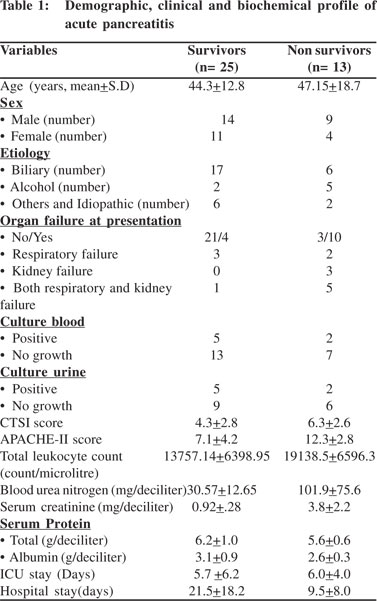
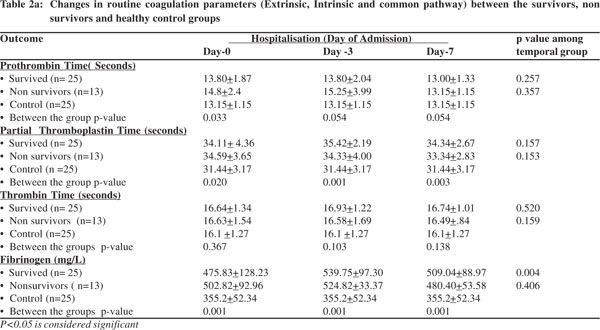
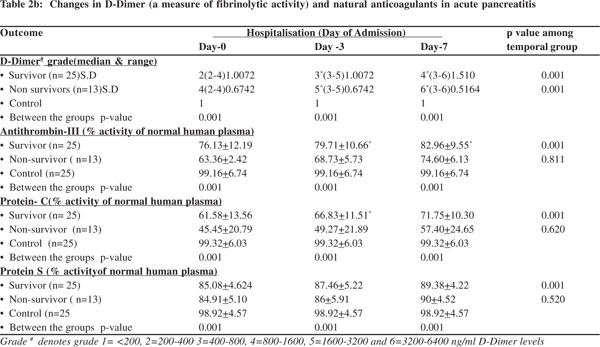 Natural anticoagulant
Antithrombin-III and protein-C levels were significantly lower in the AP patients at admission than that in the controls. The mean levels were significantly lower in non-survivors as compared to survivors (p=0.001). The mean antithrombin-III and protein-C levels followed a rising trend in both groups but at different pace. Protein-S levels were also found to be significantly lower in patients with AP as compared to the controls, but were not statistically different between the survivors and the non-survivors. In all patients, the protein-S levels followed a rising trend from day 0 to day 7. The difference in coagulation parameters between the AP patients (survived or died) and the healthy controls are shown in Table 2 a & b. The median D-dimer, antithrombin-III and protein-C levels were significantly higher in subjects with severe pancreatitis (APACHE II > 6 and/or organ failure) as compared to those who had mild disease at admission, day 3 and at day 7 (Table 3). The ROC curve analysis revealed that <71% mean activity of AT-III can predict the mortality (sensitivity 70.83%; specificity 81.82%, AUC 83%) and organ failure (sensitivity 66.67%; specificity 78.57%, AUC 0.748). Similarly, mean levels of <60% activity of protein-C predicted mortality (sensitivity 70.83%; specificity 63.64%, AUC of 0.691) and organ failure (sensitivity 62.50; specificity 64.29 AUC of 0.6830 ). The Ddimer levels of <400-800 ng/ml can predict survival (sensitivity 90.9% specificity 58.3%, AUC 70.8%) and development of organ failure (sensitivity 85.71%, specificity 54.17% AUC 68.3%) (Figures 1a, 1b, 2a and 2b). Logistic multivariate regression analysis showed cases with mean levels of <71% activity of antithrombin-III at admission had 16.6 times greater chances of mortality (p= 0.013). Also cases with the mean levels of <60% activity of protein-C had 2.4 higher fold risk for developing a fatal outcome (p= 0.21). The median D-dimer levels of 400-800 ng/mL at admission had a 11.2 times greater risk of mortality than the patients with median D-dimer levels of 200- 400 ng/mL (p=0.034). In comparison, only the presence of organ failure was associated with fatal outcome (OR 13.3 p= 0.003) (Table 4).
Natural anticoagulant
Antithrombin-III and protein-C levels were significantly lower in the AP patients at admission than that in the controls. The mean levels were significantly lower in non-survivors as compared to survivors (p=0.001). The mean antithrombin-III and protein-C levels followed a rising trend in both groups but at different pace. Protein-S levels were also found to be significantly lower in patients with AP as compared to the controls, but were not statistically different between the survivors and the non-survivors. In all patients, the protein-S levels followed a rising trend from day 0 to day 7. The difference in coagulation parameters between the AP patients (survived or died) and the healthy controls are shown in Table 2 a & b. The median D-dimer, antithrombin-III and protein-C levels were significantly higher in subjects with severe pancreatitis (APACHE II > 6 and/or organ failure) as compared to those who had mild disease at admission, day 3 and at day 7 (Table 3). The ROC curve analysis revealed that <71% mean activity of AT-III can predict the mortality (sensitivity 70.83%; specificity 81.82%, AUC 83%) and organ failure (sensitivity 66.67%; specificity 78.57%, AUC 0.748). Similarly, mean levels of <60% activity of protein-C predicted mortality (sensitivity 70.83%; specificity 63.64%, AUC of 0.691) and organ failure (sensitivity 62.50; specificity 64.29 AUC of 0.6830 ). The Ddimer levels of <400-800 ng/ml can predict survival (sensitivity 90.9% specificity 58.3%, AUC 70.8%) and development of organ failure (sensitivity 85.71%, specificity 54.17% AUC 68.3%) (Figures 1a, 1b, 2a and 2b). Logistic multivariate regression analysis showed cases with mean levels of <71% activity of antithrombin-III at admission had 16.6 times greater chances of mortality (p= 0.013). Also cases with the mean levels of <60% activity of protein-C had 2.4 higher fold risk for developing a fatal outcome (p= 0.21). The median D-dimer levels of 400-800 ng/mL at admission had a 11.2 times greater risk of mortality than the patients with median D-dimer levels of 200- 400 ng/mL (p=0.034). In comparison, only the presence of organ failure was associated with fatal outcome (OR 13.3 p= 0.003) (Table 4).
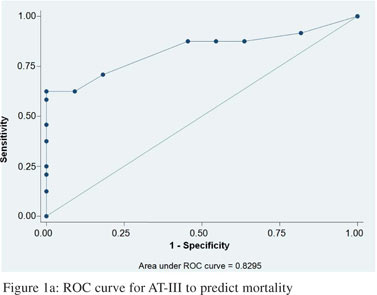
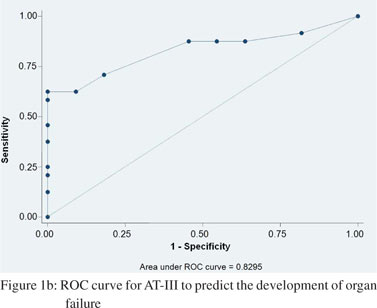
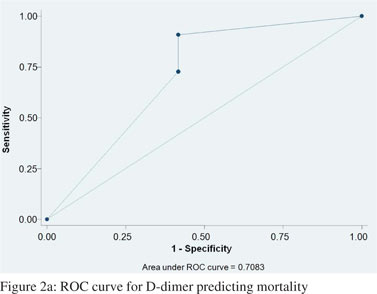
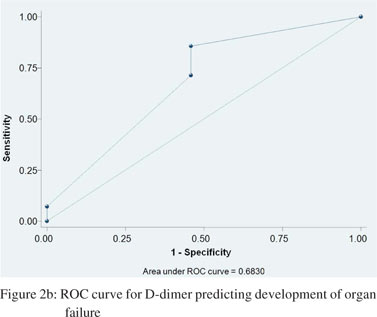
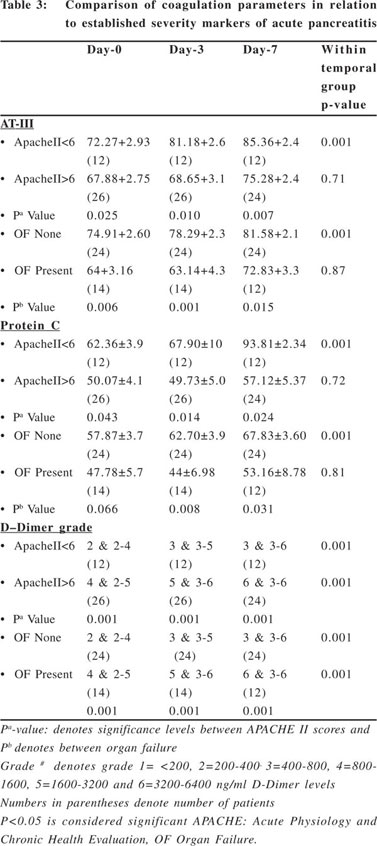
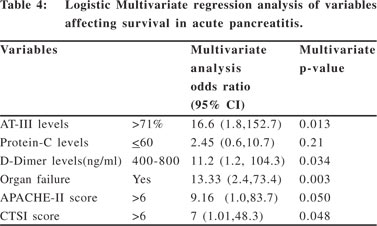 Discussion
The present study demonstrated high levels of fibrinogen and D-dimer in acute pancreatitis. Such findings have also been noted in previously reported studies,[10,11] which is in contrast to the established diagnostic criteria for laboratory markers of disseminated intravascular coagulation,[12] that does not include high levels of fibrinogen. Interestingly, acute inflammatory response in a variety of acute conditions including acute pancreatitis has been associated with a similar pattern of haemostatic changes.[12] High levels of fibrinogen in the present study indicates a serious compensatory mechanism at work. Fibrinogen is also an acute phase reactant.[13] Increased synthesis of fibrinogen is also contributed by this mechanism of acute severe inflammation. The raised D-dimer levels suggests occurrence of fibrinolysis, which is a consistent occurrence in these patients.
In addition, the present study found low levels of all natural anticoagulants like AT-III, protein-C and protein-S. This is in contrast to an old study which reported high antithrombin levels in AP.[14] Thus, it appears that, in acute pancreatitis fibrinogen synthesis and fibrinolysis goes hand in hand, depending upon the intensity of inflammatory response. Also, the natural anticoagulants mechanism work to combat the hyperactive coagulative mechanism.
The natural anticoagulant mechanisms are both up and down regulated[15] during acute phase reactions. Proinflammatory cytokines induce an increased synthesis of antithrombin-III, while impairing the hepatic synthesis of protein-C. Increased synthesis and an enhanced consumption of antithrombin-III is reflected in its plasma levels.[16,17] The decrease in plasma protein-C suggests that this antithrombotic mechanism is down regulated by inflammation.[18] Decrease in plasma protein-S levels noted in acute phase reaction would also accounts for low protein-C levels. An increase in plasma level of c4b binding protein, being an acute phase reactant, binds with protein-S resulting in reduced levels and reduced cofactor activity for activated protein-C.[19] The protein-C pathway is both a major physiological anticoagulant system and a central link between inflammation and coagulation.[20]
Raised D-dimer levels indicate activation of fibrinolysis, which always occur in acute pancreatitis. However, the extent of fibrinolysis is related to the severity of disease and may progress gradually from mere activation to a greater involvement of the coagulation system with progression to a pre-DIC state and finally to evident DIC associated with multiorgan failure. D-dimer levels of 400-800 ng/L at admission had a 11.2 times greater risk of death in patients than in patients with a median D-dimer level of 200-400 ng/L (p=0.034). The levels of D-dimer were also two times higher in those who had organ failure. This finding would contribute towards assessing the outcome of disease in patients at admission and during their stay in the hospital especially in the first week after disease onset. These findings are quite similar to other studies assessing their role in severity and organ failure.[21,22]
The significant low mean levels of AT-III and protein-C in acute pancreatitis associated with organ failure and mortality could also contribute towards the assessment of outcome of the disease. Pancreatitis with <71% mean activity of AT-III at admission has a 16.6 time more chance of fatal outcome (p=0.013). These findings are similar to previous study which revealed that severe pancreatitis had decrease in AT-III <68% and increase in D-dimer levels >693 ng/ml.[21] Also, the patient with <60% mean activity of protein-C had 2.4 odds for resulting/ developing fatal outcome than the patients with levels more than this. Similar observations have been made earlier in various studies.10 This study, however, did not show any linkage between protein-S levels and the progress or outcome in AP (p=0.21). Coagulation changes when compared to APACHEII score and organ failure indicate that constituent of APACHEII score is related to the development of coagulation disorders. Since the present study was confined to first seven days of AP, and septicemia usually occurs in the second week, no relation was found between CTSI and sepsis with coagulation profiles.
This is a novel study as for the first time it has investigated the coagulation changes in a comprehensive and holistic way and compared the changes with the established severity markers in AP like APACHE-II score, CTSI index, organ failure and sepsis. The D-dimer estimation by latex agglutination method is very simple and can be done even at the primary health care level, which can be particularly of value in resource limited settings in developing countries. The drawbacks of this study include : a small sample size and Measurement of D-dimer levels by semi-quantitative method due to financial constraints. No measurement was done on other acute phase markers like interleukins and C-reactive protein. Tissue factors were also not estimated in this study.
In conclusion, coagulation disorders in acute pancreatitis are due to the acute inflammatory response resulting in profound fibrinolysis, activation and down regulation of natural anticoagulants. Further, the extent of fibrinolysis (as indicated by D-dimer levels) is related to the severity of the disease and can be correlated with multi-organ failure. Low levels of AT-III at the time of admission can be used as a laboratory tool to judge the severity of acute pancreatitis at onset and subsequently in predicting survival. Also, in medical management, coagulation parameters can be used not only to judge the severity and assess the need for early referral to an expert centre but can also be used (anticoagulants) in the treatment of disease. Moreover, in resource-scarce countries acute pancreatitis can be stratified in a cost effective way at all healthcare levels by measuring D-dimer levels by latex agglutination method. However, further studies with a larger sample size are recommended to elucidate the role of extrinsic and intrinsic coagulation pathways and the role of activation of fibrinolytic processes in the pathogenesis of acute pancreatitis or in the pathogenesis of its complications.
References
Discussion
The present study demonstrated high levels of fibrinogen and D-dimer in acute pancreatitis. Such findings have also been noted in previously reported studies,[10,11] which is in contrast to the established diagnostic criteria for laboratory markers of disseminated intravascular coagulation,[12] that does not include high levels of fibrinogen. Interestingly, acute inflammatory response in a variety of acute conditions including acute pancreatitis has been associated with a similar pattern of haemostatic changes.[12] High levels of fibrinogen in the present study indicates a serious compensatory mechanism at work. Fibrinogen is also an acute phase reactant.[13] Increased synthesis of fibrinogen is also contributed by this mechanism of acute severe inflammation. The raised D-dimer levels suggests occurrence of fibrinolysis, which is a consistent occurrence in these patients.
In addition, the present study found low levels of all natural anticoagulants like AT-III, protein-C and protein-S. This is in contrast to an old study which reported high antithrombin levels in AP.[14] Thus, it appears that, in acute pancreatitis fibrinogen synthesis and fibrinolysis goes hand in hand, depending upon the intensity of inflammatory response. Also, the natural anticoagulants mechanism work to combat the hyperactive coagulative mechanism.
The natural anticoagulant mechanisms are both up and down regulated[15] during acute phase reactions. Proinflammatory cytokines induce an increased synthesis of antithrombin-III, while impairing the hepatic synthesis of protein-C. Increased synthesis and an enhanced consumption of antithrombin-III is reflected in its plasma levels.[16,17] The decrease in plasma protein-C suggests that this antithrombotic mechanism is down regulated by inflammation.[18] Decrease in plasma protein-S levels noted in acute phase reaction would also accounts for low protein-C levels. An increase in plasma level of c4b binding protein, being an acute phase reactant, binds with protein-S resulting in reduced levels and reduced cofactor activity for activated protein-C.[19] The protein-C pathway is both a major physiological anticoagulant system and a central link between inflammation and coagulation.[20]
Raised D-dimer levels indicate activation of fibrinolysis, which always occur in acute pancreatitis. However, the extent of fibrinolysis is related to the severity of disease and may progress gradually from mere activation to a greater involvement of the coagulation system with progression to a pre-DIC state and finally to evident DIC associated with multiorgan failure. D-dimer levels of 400-800 ng/L at admission had a 11.2 times greater risk of death in patients than in patients with a median D-dimer level of 200-400 ng/L (p=0.034). The levels of D-dimer were also two times higher in those who had organ failure. This finding would contribute towards assessing the outcome of disease in patients at admission and during their stay in the hospital especially in the first week after disease onset. These findings are quite similar to other studies assessing their role in severity and organ failure.[21,22]
The significant low mean levels of AT-III and protein-C in acute pancreatitis associated with organ failure and mortality could also contribute towards the assessment of outcome of the disease. Pancreatitis with <71% mean activity of AT-III at admission has a 16.6 time more chance of fatal outcome (p=0.013). These findings are similar to previous study which revealed that severe pancreatitis had decrease in AT-III <68% and increase in D-dimer levels >693 ng/ml.[21] Also, the patient with <60% mean activity of protein-C had 2.4 odds for resulting/ developing fatal outcome than the patients with levels more than this. Similar observations have been made earlier in various studies.10 This study, however, did not show any linkage between protein-S levels and the progress or outcome in AP (p=0.21). Coagulation changes when compared to APACHEII score and organ failure indicate that constituent of APACHEII score is related to the development of coagulation disorders. Since the present study was confined to first seven days of AP, and septicemia usually occurs in the second week, no relation was found between CTSI and sepsis with coagulation profiles.
This is a novel study as for the first time it has investigated the coagulation changes in a comprehensive and holistic way and compared the changes with the established severity markers in AP like APACHE-II score, CTSI index, organ failure and sepsis. The D-dimer estimation by latex agglutination method is very simple and can be done even at the primary health care level, which can be particularly of value in resource limited settings in developing countries. The drawbacks of this study include : a small sample size and Measurement of D-dimer levels by semi-quantitative method due to financial constraints. No measurement was done on other acute phase markers like interleukins and C-reactive protein. Tissue factors were also not estimated in this study.
In conclusion, coagulation disorders in acute pancreatitis are due to the acute inflammatory response resulting in profound fibrinolysis, activation and down regulation of natural anticoagulants. Further, the extent of fibrinolysis (as indicated by D-dimer levels) is related to the severity of the disease and can be correlated with multi-organ failure. Low levels of AT-III at the time of admission can be used as a laboratory tool to judge the severity of acute pancreatitis at onset and subsequently in predicting survival. Also, in medical management, coagulation parameters can be used not only to judge the severity and assess the need for early referral to an expert centre but can also be used (anticoagulants) in the treatment of disease. Moreover, in resource-scarce countries acute pancreatitis can be stratified in a cost effective way at all healthcare levels by measuring D-dimer levels by latex agglutination method. However, further studies with a larger sample size are recommended to elucidate the role of extrinsic and intrinsic coagulation pathways and the role of activation of fibrinolytic processes in the pathogenesis of acute pancreatitis or in the pathogenesis of its complications.
References
- Lasson A, Ohlsson K. Disseminated intravascular coagulation and antiprotease activity in acute human pancreatitis. Scand J Gastroenterol Suppl. 1986;126:35–9.
- Lasson A, Ohlsson K. Consumptive coagulopathy, fibrinolysis and protease- antiprotease interactions during acute human pancreatitis. Thromb Res. 1986;41:167–83.
- Ranson JH, Lackner H, Berman IR, Schinella R. The relationship of coagulation factors to clinical complications of acute pancreatitis. Surgery. 1977;81:502–11.
- Jayachandran K, Venkatakrishnan L, Nagarajan S. Acute pancreatitis with disseminated intravascular coagulation. J Assoc Physicians India. 1993;41:397.
- Formela LJ, Galloway SW, Kingsnorth AN. Inflammatory mediators in acute pancreatitis. Br J Surg. 1995;82:6–13.
- Kusske AM, Rongione AJ, Reber HA. Cytokines and acute pancreatitis. Gastroenterology. 1996;110:639–42.
- Aggarwal N, Pitchumoni CS. Acute pancreatitis: a multisystemic disease. Gastroenterologist. 1993;1:115–28.
- Penner JA. Disseminated intravascular coagulation in patients with multi organ failure of non-septic origin. Semin Thromb Hemost. 1998;24:45–52.
- Carrey MJ, Rodgers GM. Disseminated intravascular coagulation: clinical and laboratory aspects. Am J Hematol. 1998;59:65–73.
- Salomone T, Tosi P, Palareti G, Tomassetti P, Migliori M, Guariento A, et al. Coagulative disorders in human acute pancreatitis: role of D-dimer. Pancreas. 2003;26:111–6.
- Segal I, Chaloner C, Douglas J, John KD, Zaidi A, Cotter L, et al. Acute pancreatitis in Soweto, South Africa: relationship between trypsinogen load, trypsinogen activation, and fibrinolysis. Am J Gastroenterol. 2002;97:883–92.
- Brudascã I, Cucuianu M, Manea LP. Experimental acute inflammatory reaction and hemostatic variables. Bulletin of University of Agricultural Sciences and Veterinary Medicine Cluj- Napoca. Veterinary Med. 2006;63:1–20.
- Heinrich J, Balleisen L, Schulte H, Assmann G, van de Loo J. Fibrinogen and factor VII in the prediction of coronary risk. Results from the PROCAM society in healthy men. Arterioscler Thromb. 1994;14:54–9.
- Innerfield I, Angrist A, Benjamin W. Antithrombin titer in acute pancreatitis. Am J Med.1952;12:24–33.
- Levi M, Ten Cate H. Disseminated intravascular coagulation. N Engl J Med. 1999;341:586–92.
- Cucuianu A, Brudascã I, Colhon D, Paþiu M, Basarab C, Cucuianu M. Plasma protein C and antithrombin III in patients with acute leukemia. Rom J Intern Med. 1994;32:209–14.
- Plesca LA, Bodizs G, Cucuianu M, Colhon D. Hemostatic balance during the inflammatory reaction; with special reference to antithrombin III. Rom J Physiol. 1995;32:71–6.
- Cucuianu M, Brudasca I, Trif I, Stancu A. Clinical studies on plasma protein C. Correlation with serum cholinesterase. Nouv Rev Fr Hematol. 1993;35:481–6.
- Brudasca I, Cucuianu M, Stancu A, Colhon DM. Plasma protein S-antigen in selected disease states. Rom J Intern Med. 1994;32:29–35.
- Mentula P, Kylänpää-Bäck ML, Kemppainen E, Takala A, Jansson SE, Kautiainen H, et al. Decreased HLA (human leucocyte antigen)-DR expression on peripheral blood monocytes predicts the development of organ failure in patients with acute pancreatitis. Clin Sci (Lond). 2003;105:409–17.
- Dronov OI, Koval’s’ka IO, Burmich KS, Tsymbaliuk RS, Uvarov VIu, Lubenets’ TV. Hemocoagulation disorders in patients with acute pancreatitis. Lik Sprava. 2010;(7–8):38–44.
- Radenkovic D, Bajec D, Ivancevic N, Milic N, Bumbasirevic V, Jeremic V, et al. D-dimer in acute pancreatitis: a new approach for an early assessment of organ failure. Pancreas. 2009;38:655–60.
|
|
|
 |
|
|